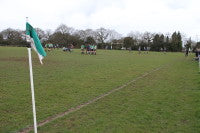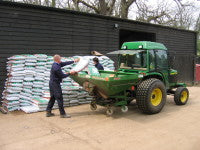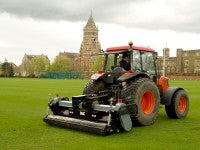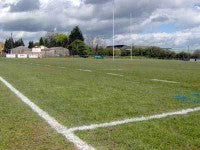April Rugby Diary 2010
 The recent run of poor weather has not been conducive for looking after winter games pitches. Clubs with heavy soil pitches, especially ones with no drainage, have suffered as a consequence of playing during wet and saturated conditions. Grass cover is soon lost and will be difficult to recover until we get some consistent soil temperatures above 12 degrees C.
The recent run of poor weather has not been conducive for looking after winter games pitches. Clubs with heavy soil pitches, especially ones with no drainage, have suffered as a consequence of playing during wet and saturated conditions. Grass cover is soon lost and will be difficult to recover until we get some consistent soil temperatures above 12 degrees C.
Pitches may be showing signs of heavy wear, particularly from scrummages and line out play. These areas invariably lose grass cover, but this season the problems have been made worse by the severe winter we have experienced in many parts of the country.
However, the problems are compounded by the fact that many clubs fail to undertake appropriate maintenance regimes, particularly in the form of regular aeration, feeding and mowing which would promote better rooting and sward density.
I see far too many clubs that have neglected these maintenance operations with the net result of having poor pitches. It is important clubs realise they must invest in their pitches.
Once grass cover has been lost it is important to re establish grass cover as quick as possible with an overseeding programme. 
Some Groundsmen will, if time and resources are available, overseed these areas during April while there is sufficient natural moisture in the ground for seed germination. However, many are not able to do this until the season has finished.
April is a good month for carrying out any aeration works, especially while there is sufficient soil moisture to allow deep penetration of the tines. The ground will soon begin to dry out, reducing the opportunity for deep aeration without surface disturbance. There are a number of different methods for aerating rugby pitches. The vertidrain and earthquake machines are popular; deep aeration is a key maintenance operation to reduce soil compaction.
Increased soil and air temperatures will begin to stimulate some grass growth which, in turn, will increase the need to mow on a more frequent basis.
Ensure you have ordered materials for your end of season renovations - topdressings, seed and fertilisers, along with securing any contract labour force or hire of machinery to undertake the the programmed works.
Stadia Groundsmen will be mowing 2-3 times a week to maintain desired sward height (28 to 50mm). Rugby swards need to be mowed at least on a weekly basis to ensure they maintain sward density.
April is also a good month for applying spring and summer fertiliser products. Ideally, it is good practice to undertake at least an annual soil test to analyse the nutrient status of your soil. This will help ensure you only apply what is required and not waste money and time applying products you do not need.
 Most grounds staff will be applying a spring/summer N P K fertiliser, perhaps something like a 9:7:7, see Pitchcare Shop for range of fertiliser products which will effectively get the grass moving during April; then towards the end of April/early May applying a slow release fertiliser to see you through June/July. However, the choice of materials and how well it works can be dependant on many factors, including soil type and the weather, with moisture and warmer air temperatures being the catalyst for growth.
Most grounds staff will be applying a spring/summer N P K fertiliser, perhaps something like a 9:7:7, see Pitchcare Shop for range of fertiliser products which will effectively get the grass moving during April; then towards the end of April/early May applying a slow release fertiliser to see you through June/July. However, the choice of materials and how well it works can be dependant on many factors, including soil type and the weather, with moisture and warmer air temperatures being the catalyst for growth.
Brushing or sweeping the pitch daily helps to remove dew and remove surface debris. Using a brush or a SISIS quadraplay will restore levels and produce aesthetically pleasing stripes.
With the onset of warmer weather, there may be a need to keep an eye out for disease; temperature changes can bring on disease attacks, particularly when the turf is undernourished. Red thread can often be a threat to sports turf when the sward is in a stressed state. An application of a spring fertiliser will help the plant to become more resistant to disease attack.
Pre-match maintenance will involve inspecting the pitch for debris, mowing and marking out. There may also be the opportunity to aerate the pitch to keep it free draining. Care should be taken when marking out. It pays to select the right type of marker and paint for the job. To ensure the lines are straight it is best to string out the lines prior to marking. With the advance in technology more and more spray jet markers are now being used, they are better suited for the ground conditions experienced by most local authority and club pitches in the UK.
Post match maintenance will involve replacing any damaged grass and divots, brushing, harrowing or light rolling to restore levels. The SISIS Truplay is an ideal piece of kit for reinstating pitches after use.
With warmer temperatures likely, it will be beneficial to start seeding bare and worn areas early with the aim to re-establish some new grass cover whilst there is sufficient soil moisture for germination.
Seeding of sparse or bare areas can be carried out; the rise in spring temperatures will help germination. Use germination sheets to aid this process but remove the sheets regularly to check for diseases. Remember that without good seed to soil contact the operation is useless. Ensure you use new seed, as old material may not give you the required germination rates.
If not already done, April is still an ideal time to obtain a soil analysis of the pitch. Measure for soil Ph, nutrient levels and organic matter content, which are seen as good indicators of the condition of the soil. Once you have this information you will be in a better position to plan your season's feeding and maintenance programmes.
With the season now drawing to a close, it will be essential to check the availability of labour, materials and resources required for your end of season renovations. Do not leave it too late to order your materials and services.
The condition of your pitch will dictate what work will be required, most pitches will have lost between 50-75% grass cover during the playing season coupled with the fact that the soil profile will have become compacted. To rectify these problems it is essential that a programme of deep aeration (100-300mm deep) is carried out, followed by fertilising, overseeding and topdressing which will help restore levels, feed and re-introduce some new grasses into the playing surface.
 April tasks for Rugby
April tasks for Rugby
Aeration/When conditions allow:- Using needle tines or slits at this time of year will keep the water moving through the profile and allow air to get to the roots. On sand-based pitches spiking will help to keep the playing surface "soft", this will also enable you to tine more frequently with minimum disturbance to the grass and playing surface.
Brushing/sweeping/Daily:- Keep up with the dragbrushing/matting or harrowing when conditions permit, for dew and worm cast dispersion, this operation will also help stand the grass up prior to any maintenance work.
Disease/Daily:- Keep and eye on fungal disease attack, and use approved fungicides to treat infected areas. Early morning dew on playing surfaces often promotes the chance of disease attack. Removal of the dew will help prevent an attack of turf disease.
Divoting/After games:- An important part of the maintenance programme, particularly at this time of the year. Get on the pitch as soon as possible after games. Use a hand fork to lift depressed turf and gently pressing with the foot is the best way to return divots. On larger areas the use of harrows will help return levels. Levels may need to be restored on the scrum and line-out areas by light topdressing and raking over. Lightly roll after repair work, preferably with a pedestrian mower.
Drainage/Weekly:- Inspect drainage outfalls, channels and ditches. Ensure that they are working. Damaged and blocked outfalls will cause surface water problems.
Sand bands can easily become capped by surface soil materials, thus reducing their draining potential. Topdressing with sand materials helps to keep the bands open and permeable. Use approved sports sands and topdressings. This dressing not only keeps the bands and drainage systems viable but restores surface levels.
Fertiliser programme/As appropriate: - Apply a fertiliser dressing, if required, on the basis of the results of a soil analysis.
Grooming/ verticutting/As required: - Grooming and verticutting are operations that remove unwanted side grass growth and reduce the amount of debris in the sward. These operations are usually carried out when grass growth begins.
Harrowing/ raking/When conditions allow:- Harrowing helps to restore levels and keep surfaces open.
Irrigation equipment/As required:- Very little required. If you do have to irrigate then it is important to irrigate uniformly, ensuring the right amount of water is applied.
Goalposts/Weekly:- Inspect goal posts and sockets before and after games to check they are safe and secure.
Litter/debris/Daily:- Inspect and remove debris from the playing surface - litter or any wind blown tree debris, litter, twigs and leaves.
Machinery (Repairs and maintenance)/Daily:- Check equipment and machinery ensuring heights of cuts etc. are correct. If you have not had them in for a winter service yet, then hurry up and do so! Also, this is a good time to look and consider buying suitable new or second hand machinery.
Marking out/As Required:- Use approved marking compounds/materials. Always check your lines, it often pays to string out your lines when marking. Using a string line helps keeps the lines straight and accurate.
Playing pitch surfaces can often become muddy, which may sometimes affect the performance of wheel to wheel transfer line marking machines. To overcome this problem, other marking systems are available. Pressure jet and dry line markers are able to produce lines on uneven and muddy surfaces. The choice will be dependent on cost, efficiency and the type of line you want. Ensure the machine is clean and ready for use.
 Mowing/As required:- Maintain winter sward height at 50-75mm. The frequency of mowing will increase to maintain sward height as soil and air temperatures begin to rise initiating grass growth. Ensure your mowing blades are kept sharp and well adjusted.
Mowing/As required:- Maintain winter sward height at 50-75mm. The frequency of mowing will increase to maintain sward height as soil and air temperatures begin to rise initiating grass growth. Ensure your mowing blades are kept sharp and well adjusted.
Cutting grass in very wet conditions can often be detrimental to the playing surface. The mowers may smear and damage the surface especially when turning. The quality of cut can be affected if the grass is very wet.
Soil tests/Ideally once or twice a year, or as required:- Good time to do your soil testing in readiness for the new growing season. Money can be wasted on inappropriate feeding.
Soil sampling is an important part of Groundsmanship. The results will enable the manager to have a better understanding of the current status of his soil and turf. There are many tests that can be undertaken, but usually the main tests to consider are:
Particle Size Distribution (PSD): this will give you accurate information on the soil type and it's particle make up, enabling you to match up with appropriate top dressing materials and ensuring you are able to maintain a consistent hydraulic conductivity (drainage rate) of your soil profile.
Soil pH: it is important to keep the soil at a pH of 5.5-6.5, a suitable level for most grass plants.
Organic matter content: it is important to keep a balanced level of organic matter content in the soil profile.
Nutrient Levels: Keeping a balance of N P K nutrients within the soil profile is essential for healthy plant growth.
Once you have this information you will be in a better position to plan your season's feeding and maintenance programmes.
